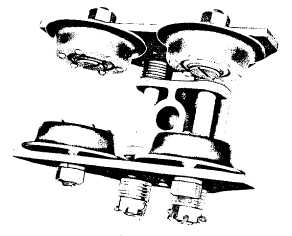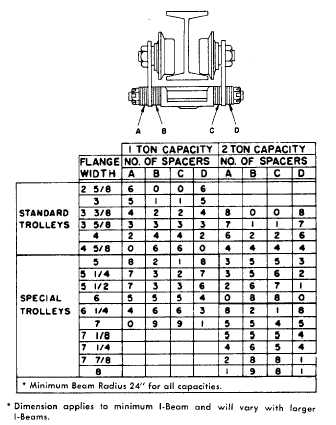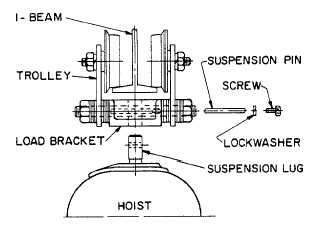All Trolleys
For all trolley supported hoists, rail stops must
be installed. These stops must not be positioned to
exert impact force on the hoist but should contact the
end of the trolley side frames.
Low Headroom Trolley
This trolley is packed separately and must be
properly adjusted by the user to fit the runway beam as
follows:
1.
Arrange the side frames, load bracket, spacer
washers and nuts on the suspension bolts
according to Figure 6 and Chart 1. (Warning,
special trolleys shown in chart require special
suspension bolts). Do not assemble cotter pins
to the bolts.
FIGURE 6. LOW HEADROOM LODESTAR TROLLEY.
2.
The number of spacers as given in Chart I is
nominally correct, however, due to the variation
in size encountered on structural steel sections,
it will be necessary in some cases to vary the
number used. Therefore, the distance between
the trolley trackwheel flanges, and the beam
flange width should be measured to determine
the exact distribution of the spacer washers. The
distance between trackwheel flanges should be
1/8" to /';" greater than the width of the beam
flange for straight runway beams and 3/16 to
1/4" if runway system includes sharp curves.
The number of spacer washers between side
frames and load bracket should be the same or
differ only by one spacer to keep the hoist hook
centered under the runway beam.
3.
Install the trolley on beam by sliding one side
frame out far enough to allow the trackwheels to
clear the beam flange.
WARNING:
Deviation
from
CM
washer
recommendations can cause trolley to fall from the
beam. The trolley should be inspected periodically to
assure its continued operation.
CHART I -TROLLEY SIDE FRAME SPACING.
4.
Draw the side frames together and assemble
cotter pins.
FIGURE 7.
ATTACHING HOIST TO TROLLEY.
7





